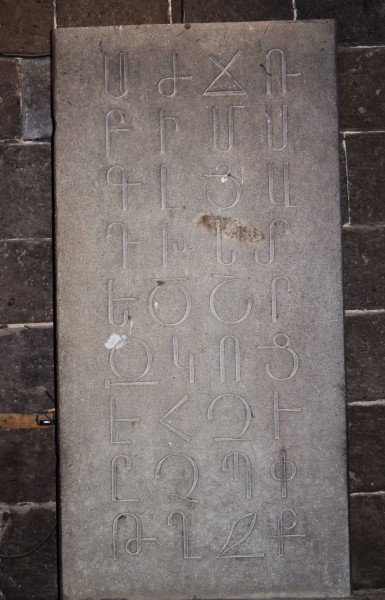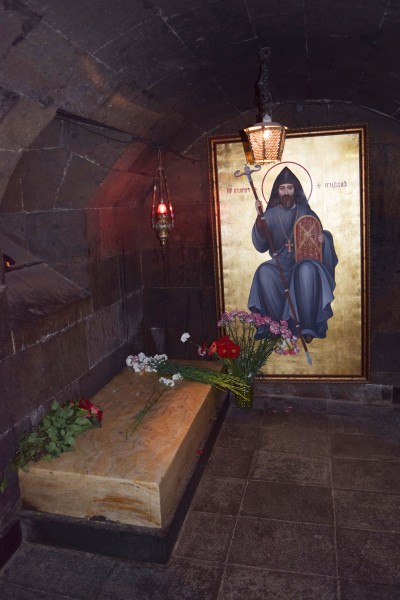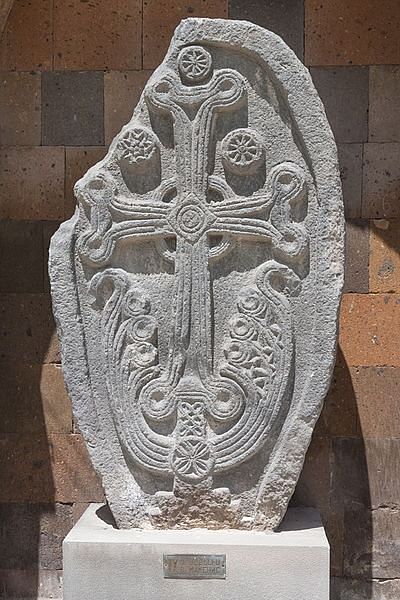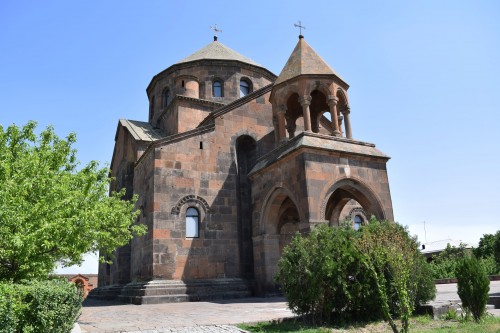Mesrop Mashtots › Vagharshapat (Valarsapat) » Ancient origins
Articles and Definitions › Contents
- Mesrop Mashtots › Antique Origins
- Vagharshapat › Ancient History
Ancient civilizations › Historical and archaeological sites
Mesrop Mashtots › Antique Origins
Definition and Origins

Mesrop Mashtots (360/370 - c. 440 CE) invented the Armenian alphabet in 405 CE. Besides greatly increasing levels of literacy in the country, the language permitted ordinary people to read the Bible for the first time, thus helping to further spread and entrench Christianity in Armenia, which was the original intention behind the script 's invention. For these achievements Mashtots (Mastoc) was made a saint of the Armenian Church.
EARLY LIFE
CREATING A NEW ALPHABET
Fortunately for Mashtots, the founder of the ruling Arsacid dynasty, Tiridates the Great (rc 298 - c. 330 CE), had converted to Christianity in 301 CE thanks to the efforts of Saint Gregory the Illuminator (c. 239 - c. 330 CE). Tiridates' successors were equally keen on spreading Christianity, especially as it reinforced the role of the monarch in the state as God's representative, and allowed the Arsacids to persecute and confiscate the property of any lingering adherents to the old pagan traditions. The reigning Arsacid monarch, then, Vrampshapuh (r. 392-415 CE), was willing to patronise Mashtots' project. Another supporter was the head bishop of the Armenian church, the Catholicos Sahak the Great (387-428 CE). Both men saw the value of enlightening the people and at the same time unifying them and creating a greater spirit of nationhood. Finally, the Christian faith in Armenia was far from secure and was continuously threatened by the religion of the neighbouring Persia.
MASHTOTS PUT HIS CREATION TO THE PURPOSE FOR WHICH IT WAS REALLY INVENTED: TO SPREAD THE CHRISTIAN MESSAGE.
Mashtots began his task by researching possible existing languages which might most easily be adapted for his purpose. For this, he visited Edessa in northern Syria, a great centre of culture and learning, especially Christian scholarship. Disappointed in his quest, Mashtots decided that nothing short of a whole new alphabetic script was required. Relocating to Samosata, a Hellenized city in western Armenia, Mashtots discovered that the link between the Greek and Armenian languages could be exploited to create a coherent and practical script. Assisted by Rufinus, a Greek calligrapher, Mashtots compiled his alphabet of 36 symbols (28 consonants and 8 vowels) to capture the phonetic sounds of Armenian. The traditional date for the finished product is 405 CE, and it remains in use today with only two symbols added in later centuries to express sounds imported from foreign languages.

Monument to Armenian Alphabet at Oshakan
Mashtots' new alphabet mixed 21 Greek letters with 15 new phonemes. The Historical Dictionary of Armenia gives the following technical description of the complexity of the language:
Classical Armenian was a highly inflected language, with an elaborate system of declensions that retained all seven Indo-European noun cases: nominative, accusative, genitive, dative, locative, ablative, and instrumental.In this and other respects, the grammar of classical Armenian bears similarities with that of Classical Greek.(393)
To help people get to grips with the new system Mashtots ordered the letters of the alphabet, when possible, according to the Greek alphabet and put them into harmonious clusters of three. The linguist then set about testing the system on friends and pupils to see which symbols proved more troublesome in mastering. His efforts were clearly worthwhile given the speed with which the new alphabet was picked up across Armenia. Not only helping to increase literacy and usher in a golden period of Armenian literature, it was another important factor in unifying the Armenian people, cementing their identity and sense of nationhood in what was still a young state.
MASHTOTS & THE BISHOP SAHAK ASSUMED PERSONAL RESPONSIBILITY FOR THE REALLY BIG PROJECT: TRANSLATING THE BIBLE.
TRANSLATING THE BIBLE
Mashtots' work was not finished there, though. Now he had to put his creation to the purpose for which it was really invented: to spread the Christian message. Realising that he could not do this alone, the scholar set about assembling a trained team of linguists who were sent off to various cities to learn Greek or Syriac and who were then given the task of translating canons of the early church councils, liturgies, patristic texts and any other sources of value. Mashtots and the bishop Sahak assumed personal responsibility for the really big project: translating the Bible. Getting themselves an official copy from Constantinople, they cross-referenced it with other versions in Greek and Syriac to produce their definitive version in Armenian. The opening line of the Armenian Bible chosen by Mashtots was from the Proverbs of Solomon : “That men may know wisdom and instruction”.
LATER LIFE & LEGACY
Mashtots did not limit himself to translation work but also produced brand new literature in his brand new script. The scholar composed many hymns and homilies, amongst other works. In the first biography of Mashtots (and the first Armenian biography to be written), titled The Life of Mashtots ( Vark Mashtotsi ) and written by his pupil Koriun, the scholar is credited with inventing the Georgian and Albanian alphabets.

Mesrop Mashtots' Tomb
Mesrop Mashtots died in the Armenian capital of Vagharshapat on 17 February 439 (or 440 CE). He was buried in Oshakan which became a site of pilgrimage thereafter, especially following his raised status as a saint of the Armenian Church. Mesrop Mashtots continues to be revered today, too, by modern Armenians as here explained by the political historian R. Panossian:
The celebration of the alphabet and the literary work of the fifth century is sanctioned by the Armenian church as an official holiday (in October) called Surb Tarkmanchats (Holy Translators). It is noted both by the church and the laity in Armenia and in the diaspora as a celebration of Armenian literature and books. (46)
Saint Mashtots' work continues to live on today as, while the lower case of modern Armenian is based on the medieval script, the upper case of the alphabet he invented 16 centuries ago is still in use today.
This article was made possible with generous support from the National Association for Armenian Studies and Researchand the Knights of Vartan Fund for Armenian Studies.
Vagharshapat › Ancient History
Definition and Origins

Vagharshapat (Valarsapat), located some 20 km west of modern Yerevan, was an ancient city in Armenia founded in the 2nd century CE. Serving as the capital, the city prospered and, under the new name of Echmiadzin, became the spiritual capital of Christian Armenia from the 4th century CE. Still an important pilgrimage site today, the building of the cathedral at Vagharshapat is attributed to Saint Gregory the Illuminator who was, in a vision, instructed by Christ to build it there after he descended and struck the ground at the very spot. The site is listed by UNESCO as a World Heritage Site.
THE ROYAL RESIDENCE
Vagharshapat was founded during the reign of the Arsacid king Vagharsh I (r. 117-140 CE), who gave his name to the new city, a common practice of the period. Artashat (Artaxata) remained the capital but Vagharshapat became the royal residence. The city was not entirely built from scratch but expanded upon the existing settlement of Vardgesavan. The city was protected by a new and encircling fortification wall.
In 166 CE Vagharshapat became the first city in Armenia following the sack of Artashat by a Roman army led by Statius Priscus. The Roman and Persian Empires had been constantly bickering over control of Armenia for its vital strategic value in the region. Priscus established a Roman garrison at Vagharshapat, and the city, known to them by its Greek name, Kaine Polis or New City, was made the new administrative capital, a position it kept even after Artashat was rebuilt a few years later.Vagharshapat was attacked and destroyed during the Sasanid invasions of 368 and 369 CE. The city was then replaced as the political capital by Dvin sometime in the 4th century CE.
IN THE LATTER HALF OF THE 4TH CENTURY CE THE SEAT OF THE FIRST BISHOP OF ARMENIA, THE KATHOLIKOS, WAS MOVED FROM ARTASHAT TO VAGHARSHAPAT.
The move of the political capital to Dvin was designed to disassociate the new regime from that of the former Armenian ruling dynasty the Arsacid dynasty (12 CE - 428 CE) and increase loyalty to Persia, which now controlled that part of Armenia. A Persian viceroy or marzpan had his palace at Dvin but Vagharshapat was not about to be consigned to obscurity for it became the religious capital of Armenia under the new name of Echmiadzin (aka Etchmiadzin or Edjmiadsin).
A RELIGIOUS CAPITAL: ECHMIADZIN
During the reign of Tiridates the Great (rc 298 - 330 CE) Christianity was formally adopted as the state religion of Armenia, and the king himself was said to have been converted in 301 CE by Saint Gregory the Illuminator in the royal palace at Vagharshapat. Some of the earliest churches in the country were built in the city. In the latter half of the 4th century CE the seat of the first bishop of Armenia, the katholikos, was moved from Artashat to Vagharshapat (it would later be moved again, this time to Dvin). This is traditionally seen as the work of the katholikos Sahak (r. 387-428 CE). The city became a focal point from which the tentacles of the Armenian Apostolic Church spread out to convert the entire country. The famed clergyman and scholar Mesrop Mashtots (360/370 - c. 440 CE), who invented the Armenian alphabet, resided here.

Arsacid Armenia
One of the most tangible and long-lasting manifestations of Vagharshapat's roles as the spiritual centre of Armenia was, and is, the great cathedral dedicated to the Mother of God. Said to have been built by Saint Gregory following a vision in which Christ descended to earth and indicated the very spot, the cathedral thus explains the city's new name of Echmiadzin, meaning “The Only-Begotten-One Descended”. Archaeological evidence suggests that the cathedral was built, no doubt intentionally, on the site of a pagan fire altar, as revealed by archaeological excavations in 1957 CE. The version of the cathedral which stands at the site today dates to 483 CE after the then ruler Vahan Mamikonian commissioned an upgrade on Saint Gregory's first structure. The cathedral was a compensation, perhaps, for the moving of the church's headquarters to Dvin in 485 CE.
A PILGRIMAGE SITE
Another 5th-century CE addition to the city's Christian architecture was a monastery with its first prior being the famous scholar and historian Ghazar Parpetsi. In time, the monastery accumulated an impressive manuscript library. Over the following two centuries, successive bishops ensured the building programme continued. In the 7th century CE, under the guidance of the bishop Komitas of Aghdzk (r. 615-628 CE), Echmiadzin began to pull in even more pilgrims following the construction of the particularly splendid church of Saint Hripsime which was named after the virgin who had been martyred by Tiridates the Great prior to his conversion to Christianity. Indeed, the church was said to have been built on the very spot of Hripsime's death. The church of Saint Gayane was added around 616 CE and, in the 650s CE, the completion of the impressive Zvartnots cathedral nearby only added to the attractions which ensured Echmiadzin became one of the most important pilgrimage sites in Armenia.

Saint Hripsime Church Façade
LATER HISTORY
Following the invasion and occupation of Armenia by the Umayyad Caliphate from 640 CE the position of Echmiadzin as a major religious centre became precarious. Dvin and then Ani were the political and religious capitals, and Echmiadzin slowly fell into decline. A major earthquake struck the region in the 10th century CE which caused the collapse of the church of Zvartnots, amongst other buildings. By the late 13th century CE the site was so dilapidated that the celebrated poet Stepanos Orbelian (d. 1304 CE) felt compelled to compose his Lamentations on the Holy Cathedral of Vagharshapat.
Echmiadzin's fortunes revived when the Armenian church decided to restore the catholicosate to the site in the mid-15th century CE. The country and its Christians endured troubled times under Turkish rule but Echmiadzin's monastery was given certain economic privileges which at least ensured the site could maintain itself until better days arrived. These days did come but not until the late 18th century CE. It was then that the bishop Simon of Yerevan (r. 1763-1780 CE) embarked on an ambitious plan to make the site a great centre of learning, aided by generous donations from Armenians abroad, especially in India. The process began with the installation of Armenia's first printing press and a paper mill to keep it well-supplied with raw material, a new archive was established for the Armenian church's records, and a general rebuilding programme was initiated which included a new cupola and three new belfries for the cathedral. After surviving the anti-religious Soviet regime of the 20th century CE, present-day Echmiadzin has once more become a major pilgrimage centre and tourist attraction for its excellent surviving examples of Armenian medieval architecture.
LICENSE:
Article based on information obtained from these sources:with permission from the Website Ancient History Encyclopedia
Content is available under License Creative Commons: Attribution-NonCommercial-ShareAlike 3.0 Unported. CC-BY-NC-SA License